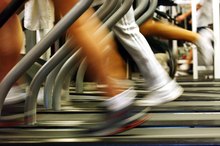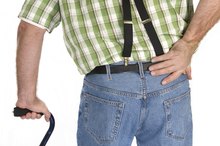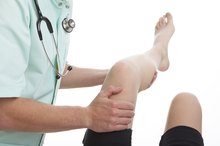4 Symptoms of Leg Weakness You Should Learn to Recognize
A lack of muscular strength may cause the legs to feel weak or unable to support the body’s weight. Leg muscle weakness symptoms may vary depending on the underlying cause of the weakness.
If you are experiencing serious medical symptoms, seek emergency treatment immediately.
Leg weakness can be caused by many different disorders, such as bilateral sciatica, which affects the muscles in both legs. It may also be caused by a spinal injury, nerve damage, brain injury or spinal malfunction. Leg weakness can resemble or be a symptom of many different disorders, including stroke and multiple sclerosis.
Read more: Causes of Leg Weakness
Numbness and Tingling
An early indicator of weakness in the legs is a tingling or numbing sensation. Numbness is a loss of feeling in the legs that may make it difficult to walk. It may also cause a patient to drag her legs or feet when she walks because of the loss of feeling. This symptom is usually the first symptom of leg weakness.
According to MedlinePlus, numbness and tingling in the legs could be caused by pressure that is placed on the nerves 3. MedlinePlus recommends seeing a doctor if the numbness in the leg seems to get worse with movement, such as walking, or from standing 34.
- An early indicator of weakness in the legs is a tingling or numbing sensation.
- Numbness is a loss of feeling in the legs that may make it difficult to walk.
Lower Back Pain
What Does It Mean When Feeling Unbalanced Walking on a Treadmill?
Learn More
Another symptom of leg muscle weakness is back pain, which can be caused by numerous disorders. Back pain that affects the legs' ability to move or function properly usually starts in the lower back.
A pinched nerve in the lower back, also known as the sciatic nerve, can cause a dull pain in the back, thus causing the muscles in the legs to become weak. According to WebMD, this type of pain usually only affects one leg and may extend all the way to the lower leg and foot 2.
Read more: Sciatica Stretching Exercises
- Another symptom of leg muscle weakness is back pain, which can be caused by numerous disorders.
- A pinched nerve in the lower back, also known as the sciatic nerve, can cause a dull pain in the back, thus causing the muscles in the legs to become weak.
Falling and Loss of Balance
Falling or the fear of falling with leg weakness is very common. When the muscles are not strong enough to carry the body’s weight, it may cause an individual to fall before walking begins.
Muscle weakness in the leg may cause the leg to feel heavy or limp, making it difficult to walk properly. According to NeuroSymptoms.org, an individual experiencing leg weakness may appear as if he has had a stroke 1. However, unlike a stroke, he is still able to feel his legs and may also have normal leg reflexes. When the individual experiences a heavy or limp feeling in the legs, it may result in occasional falling.
- Falling or the fear of falling with leg weakness is very common.
- When the muscles are not strong enough to carry the body’s weight, it may cause an individual to fall before walking begins.
Gait Deviation From Weakness
Limping & Back Pain
Learn More
Leg muscle weakness may result in an abnormal gait or pattern of walking. For example, according to MedLinePlus, if there is muscle weakness in the tibia, an individual may have a steppage gait. With this type of gait, the individual's toes point down and may drag on the floor as the person is walking.
Other gait deviations may be seen, depending on the underlying cause of muscle weakness. Consult a doctor if you experience gait deviation or other signs of muscle weakness to discover and treat the cause of leg weakness.
Read more: Gait Exercises
- Leg muscle weakness may result in an abnormal gait or pattern of walking.
Related Articles
References
- Neurosymptoms.org: Functional Limb Weakness
- WebMD: What Are the Symptoms of Sciatica?
- MedLinePlus: Numbness and Tingling
- MedLinePlus: Walking Abnormalities
- Riggs JE. Adult-onset muscle weakness. How to identify the underlying cause. Postgrad Med. 1985;78(3):217-26.
- Tadi P, Lui F. Acute Stroke (Cerebrovascular Accident).StatPearls. Treasure Island (FL): StatPearls Publishing; 2019 Jan-.
- Mcgrogan A, Madle GC, Seaman HE, De vries CS. The epidemiology of Guillain-Barré syndrome worldwide. A systematic literature review. Neuroepidemiology. 2009;32(2):150-63. doi:10.1159/000184748
- Garg M. Respiratory Involvement in Guillain-Barre Syndrome: The Uncharted Road to Recovery. J Neurosci Rural Pract. 2017;8(3):325-326. doi:10.4103/jnrp.jnrp_96_17R1
- Guillain-Barré Syndrome Fact Sheet. National Institute of Neurological Disorders and Stroke.
- Goldenberg MM. Multiple sclerosis review. P T. 2012;37(3):175-84.
- Koes BW, Van tulder MW, Peul WC. Diagnosis and treatment of sciatica. BMJ. 2007;334(7607):1313-7. doi:10.1136/bmj.39223.428495.BE
- Thomas C, Zaidner E, Calancie B, Broton J, Bigland-Ritchie B. Muscle Weakness, Paralysis, and Atrophy after Human Cervical Spinal Cord Injury. Experimental Neurology. 1997;148(2):414-423. doi:10.1006/exnr.1997.6690
- Riggs JE. Adult-onset muscle weakness. How to identify the underlying cause. Postgrad Med. 1985;78(3):217-26. doi:10.1080/00325481.1985.11699126
- Yeo SS, Kim SH, Jang SH. Proximal weakness due to injury of the corticoreticular pathway in a patient with traumatic brain injury. NeuroRehabilitation. 2013;32(3):665-9. doi:10.3233/NRE-130889
- Beukelman D, Fager S, Nordness A. Communication Support for People with ALS. Neurol Res Int. 2011;2011:714693. doi:10.1155/2011/714693
- Zarei S, Carr K, Reiley L, et al. A comprehensive review of amyotrophic lateral sclerosis. Surg Neurol Int. 2015;6:171. doi:10.4103/2152-7806.169561
- Marchettini P, Lacerenza M, Mauri E, Marangoni C. Painful peripheral neuropathies. Curr Neuropharmacol. 2006;4(3):175-81. doi:10.2174/157015906778019536
- Barohn RJ, Dimachkie MM, Jackson CE. A pattern recognition approach to patients with a suspected myopathy. Neurol Clin. 2014;32(3):569-93, vii. doi:10.1016/j.ncl.2014.04.008
- M king W, Kissel JT. Multidisciplinary approach to the management of myopathies. Continuum (Minneap Minn). 2013;19(6 Muscle Disease):1650-73. doi:10.1212/01.CON.0000440664.34051.4d
- Pasnoor M, Barohn RJ, Dimachkie MM. Toxic myopathies. Neurol Clin. 2014;32(3):647-70, viii. doi:10.1016/j.ncl.2014.04.009
- Waning DL, Guise TA. Cancer-associated muscle weakness: What's bone got to do with it?. Bonekey Rep. 2015;4:691. doi:10.1038/bonekey.2015.59
- Nayak R. Practical approach to the patient with acute neuromuscular weakness. World J Clin Cases. 2017;5(7):270-279. doi:10.12998/wjcc.v5.i7.270
- Cho OH, Yoo YS, Kim JC, Park RH, Hwang KH. Factors influencing lower urinary tract symptoms in advanced cancer patients with chemotherapy-induced peripheral neuropathy. Int Neurourol J. 2018;22(3):192-9. doi:10.5213/inj.1836084.042 Epub 2018 Sep 28.
- Pasnoor M, Barohn RJ, Dimachkie MM. Toxic myopathies. Curr Opin Neurol. 2018;31(5):575-82. doi:10.1097/WCO.0000000000000606








